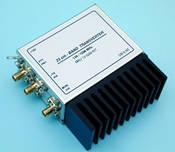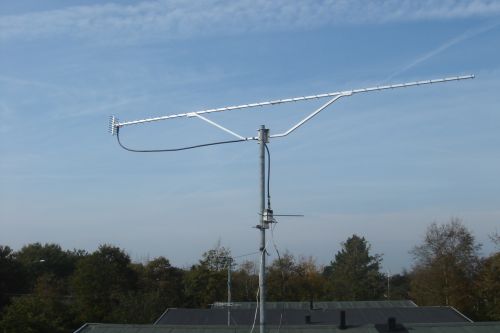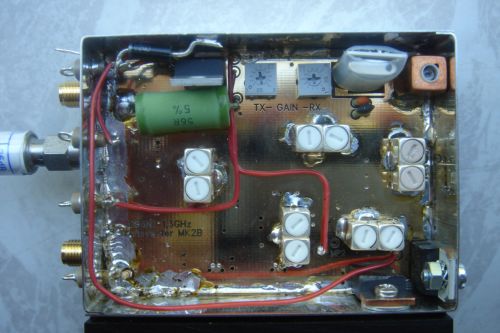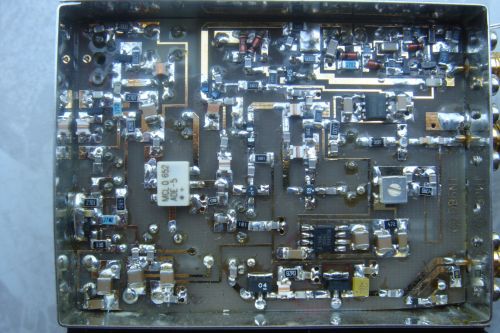1296 MHz transverter
| This page describes my effort to become QRV on the 1296 MHz band. I'll start with building a transverter: Kuhne MKU13G2B (kit). |
Building a 1296 MHz transverter

Kuhne 23 cm transverter.
|
Transverter kit I have decided to build the Kuhne MKU 13G2B kit. The Kuhne transverter covers 1296-1298 MHz and the IF is at 144-146 MHz. This kit was presented at the VHF-day in Ringsted, Denmark in February 2011 and recommended by OZ2LD Christian, who said "This kit is the cheapest and easiest way to become QRV on 23 cm". Assembly This kit is for experienced builders only. Excellent soldering skills are required. Experience with SMD components is a must. The transverter is assembled in sections, and each section is tested before moving to the next one.
Alignment values The table below displays the DC voltages, that I measured on my 1296 MHz transverter. The voltmeter was connected to ground at the transverter screen. TX OUT was terminated with a 50 ohm dummyload. RX IN was connected to a 50 ohm signal source. The power supply was 12.0 V DC.
How to adjust the transverter's RX chain using the "Milli-Beacon"signal source: I used Yaesu FT-847 as IF transceiver. Connect the IF transceiver (144 MHz) to the transverter. Insert a 26 dB attenuator between the signal source and the transverter's RX IN to prevent receiver overload. If you don't own a 26 dB attenuator, use a value close enough, for example 30 dB. 1. The signal source is turned off. Set the IF transceiver's mode to USB. Adjust the RX gain potmeter so that when the transverter is turned on, a slight rise in noise is heard in the IF transceiver. 2. Turn on the signal source and locate the signal in the IF transceiver. The transverter's crystal oscillator coil is tuned for maximum output (minimum voltage at M1). 3. Adjust F3 and F4 for maximum signal (use the S-meter of the IF transceiver). 4. F2 may be adjusted to gain a higher S-meter reading, but it should be readjusted together with the TX chain. How to adjust the transverter's TX chain Connect a dummy load to TX out. Ground the PTT terminal and check the DC values of 180 ohm/1nF, GALI4 output, and AH102 output. Set TX gain to minimum and apply a 3 W carrier at 144.5 MHz. Now follow the alignment instruction in the user handbook. Problems
|
Photos
Click on any image to enlarge.
Kuhne MKU13G2B kit - a transverter kit for 1296 MHz. Finished transverter - top view. Finished transverter - bottom view. |
 44 element yagi for the 23 cm band. The antenna is SHF 2344 from Wimo. This 44 element yagi antenna is easy to assemble as all elements are mounted at the factory. The reflector has 8 elements. The cable between antenna and transverter is Ecoflex 10 terminated with N-connectors. The 23 cm transverter is visible below the antenna (housing will be improved later). |
Written 03-Oct-2011 by OZ1BXM
Lars Petersen. Latest revision Febr 2020.


